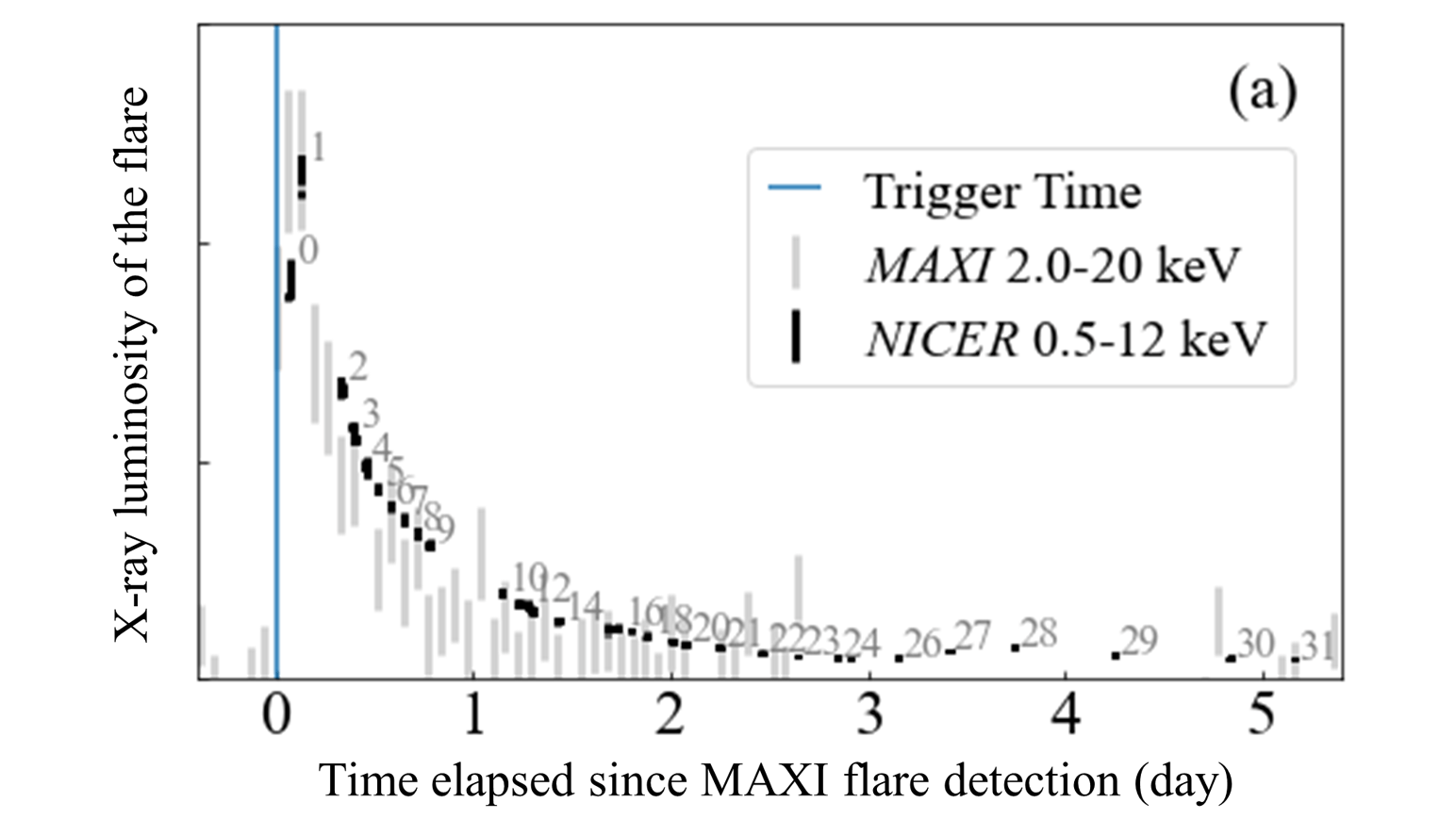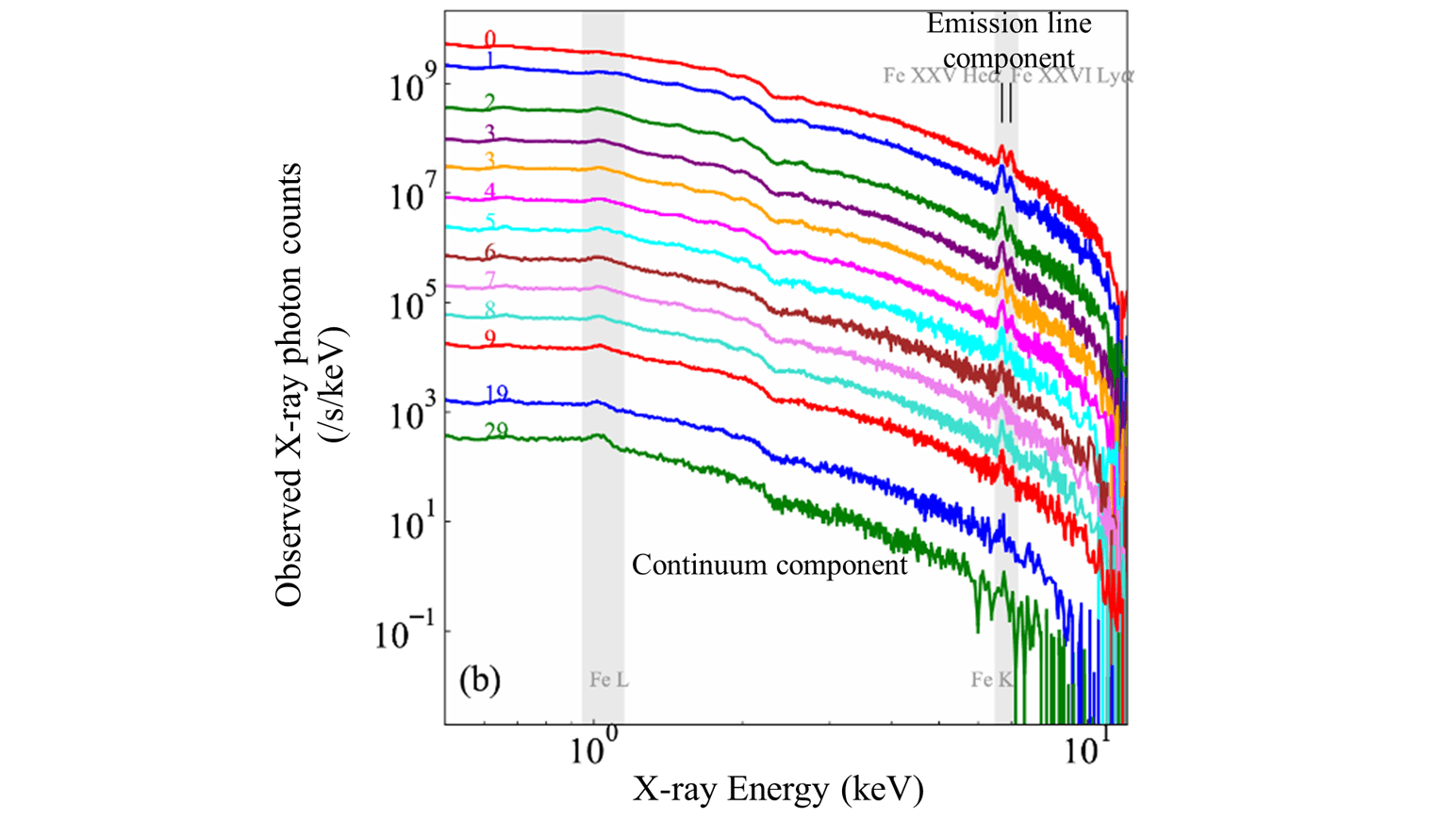A Giant Stellar Flare Captured by Two X-ray Instruments onboard the ISS: Investigation of the Non-Equilibrium Ionization Process
May. 23, 2024 | GATEWAY to Academic Articles
RS CVn-type binaries*1 are known to exhibit flares*2 that are far larger than those of the Sun, making them crucial celestial objects for investigating the mechanisms behind giant flare occurrences and their impacts on the surrounding environment. Our group has successfully discovered a flare from an RS CVn star and initiated detailed observations in an early stage of the flare. We overcame the unpredictable nature of flares by combining two X-ray observation instruments on the ISS (MAXI*3 and NICER*4: Figure 1). As a result of the NICER flare observation for ~5 days until the decay, it was revealed that the flare scale reached a million times that of the largest solar flare observed in the past. From the initial phase data of the flare, we derived properties that include the plasma*5 temperature, electron density, and flare loop*6 length. We also attempted the first discovery of observational evidence of collisionally non-equilibrium ionization (NEI) plasma in stellar flares. NEI temporarily occurs in plasma when there is a rapid change in temperature, and flares are no exception. It is a crucial aspect for better understanding the accurate physical mechanisms of flares through X-ray observation. Although collisional ionization equilibrium (CIE) *7 solution cannot be rejected by this dataset, we demonstrated NEI solution is also acceptable in the early stage of the flare and proposed future observations with stronger constraints on ionization states.
Research Summary

Stellar flares are explosive phenomena where energy accumulated in the magnetic field of a star's outer atmosphere is suddenly released. Since our Sun is also a star, it often experiences flares. The released magnetic energy can have significant impacts on the surrounding environment, such as heating plasma as thermal energy and accelerating particles as kinetic energy. In the past, large-scale flares have caused power outages on Earth, disrupting our daily lives. As the occurrence frequency of such massive flares decreases with their size, relying solely on solar observations to quantify the risk is not very practical. Hence, the stage is set for observations of numerous stars in space.

The site of a flare is a region of extremely high-temperature plasma, emitting bright X-rays. However, finding and conducting detailed observations of stellar flare phenomena, which occur unpredictably anywhere in the sky, using X-rays is not easy. Existing single X-ray observatories are typically not able to simultaneously monitor numerous celestial bodies in real-time while conducting detailed observations of individual objects. Thus, previous observations mainly relied on long time exposure, passively waiting for flare occurrences, which is inefficient. To improve this situation, our group has developed a system called MANGA (MAXI and NICER Ground Alert) to quickly capture transient X-ray brightening events such as stellar flares by coordinating two complementary X-ray instruments onboard the ISS. With this system, we successfully detected and conducted detailed follow-up observations of a flare from the RS CVn-type binary star UX Arietis just 89 minutes after the brightening was detected by MAXI, using NICER (Fig. 2).

The scale of the flare was nearly a million times larger than even the most significant solar flare recorded in the past. The analysis focused on modeling the X-ray energy spectra*8 (Fig. 3) immediately following the energy release of the flare, comprising a continuum component due to thermal Bremsstrahlung*9 radiation and emission line components due to de-excitation*10. Information from the continuum component revealed a time delay between the evolution of plasma temperature and X-ray luminosity, suggesting the timing of plasma formation within the flare loops. Additionally, estimating the half-loop length to be approximately four times the solar radius provided further evidence of the flare's magnitude.
Using information from the emission line components, we searched for observational evidence of plasma deviating from CIE, unprecedented in stellar flare phenomena outside the Sun. By comparing the temporal evolution of the emission line intensity ratio from 24th and 25th ionization stages*11 of iron with theoretical predictions, we demonstrated that plasma immediately following the flare onset can be explained by a non-equilibrium ionization state. While the current observational data did not conclusively reject the ionization equilibrium solution, we aim to pursue the goal of initial detection through simultaneous observations with other X-ray observatories such as XRISM*12 in the future.
Terminologies
- *1 RS CVn-type binary stars: Binary stars refer to systems where two stars are gravitationally bound to each other. RS CVn-type stars, exemplified by RS Canum Venaticorum (RS CVn) stars, are flare stars with relatively short orbital periods, representing a detached close binary system.
- *2 Flare (of stars): Explosive phenomena where energy accumulated in the magnetic field of a star's outer atmosphere is suddenly released.
- *3 Monitor of All-sky X-ray Image (MAXI): A whole-sky X-ray observation instrument developed by Japan and installed on the ISS "Kibo" module. Operational since August 2009, it contributes significantly to the discovery of transient celestial phenomena by updating all-sky X-ray images approximately every 90 minutes.
- *4 Neutron Star Interior Composition Explorer (NICER): An X-ray detector developed by the United States, also installed on the ISS like MAXI. It began observations in June 2017 and has been observing many X-ray astronomical objects, including neutron stars, utilizing its large effective area.
- *5 Plasma: A collection of charged particles (ions, electrons, etc.).
- *6 Flare loop: The structure observed during a flare where magnetic field lines rise arch-like from the stellar surface.
- *7 Collisional ionization equilibrium: A major process altering the ionization state of atoms in the stellar outer atmosphere are “collisional ionization” and “recombination”; collisional ionization involves collisions between ions/atoms carrying bound electrons and moving electrons, leading to "ionization" where bound electrons are stripped off, while "recombination" is a process of ions/atoms capturing surrounding electrons, increasing the ionization state. Collisional ionization equilibrium refers to a state where the rates of collisional ionization and recombination occurring per unit time are balanced.
- *8 X-ray energy spectrum: Data representing how many X-ray photons with a certain energy were observed.
- *9 Thermal Bremsstrahlung: Electromagnetic radiation emitted when electrons, undergoing thermal motion in a plasma, are decelerated by Coulomb interactions with ions.
- *10 De-excitation: In this context, it refers to the transition of an electron from an excited state to a lower state. The energy difference can be emitted as electromagnetic radiation.
- *11 N-th ionization stage of atom: ion by losing N electrons from the neutral atom.
- *12 XRISM: X-Ray Imaging and Spectroscopy Mission. An international mission led by Japan, launched from the Tanegashima Space Center in September 2023. It carries Xtend instrument with a wide field of view and the Resolve instrument with excellent spectroscopic capabilities.
Information
| Journal Title | The Astrophysical Journal |
|---|---|
| Full title of the paper | Investigation of non-equilibrium ionization plasma during a giant flare of UX Arietis triggered with MAXI and observed with NICER |
| DOI | https://doi.org/10.3847/1538-4357/ad35c5 |
| Publish date | 2024 April 16 |
| Author(s) | Miki Kurihara, Wataru Buz Iwakiri, Masahiro Tsujimoto, Ken Ebisawa, Shin Toriumi, Shinsuke Imada, Yohko Tsuboi, Kazuki Usui, Keith C. Gendreau, Zaven Arzoumanian |
| ISAS or JAXA member(s) among author(s) | KURIHARA Miki (Dept. of Astronomy, The University of Tokyo & Dept. of Space Astronomy and Astrophysics, ISAS), TSUJIMOTO Masahiro (Dept. of Space Astronomy and Astrophysics, ISAS), EBISAWA Ken (Dept. of Space Astronomy and Astrophysics, ISAS & Dept. of Astronomy, The University of Tokyo), TORIUMI Shin (Dept. of Solar System Sciences, ISAS) |
Links
- Monitor of All-sky X-ray Image: MAXI
- Neutron Star Interior Composition Explorer: NICER
- X-Ray Imaging and Spectroscopy Mission: XRISM
- Personal site (KURIHARA Miki)
- ISAS Ebisawa Lab site
- NICER article about this paper


 KURIHARA Miki / Dept. of Astronomy, The University of Tokyo,
KURIHARA Miki / Dept. of Astronomy, The University of Tokyo,